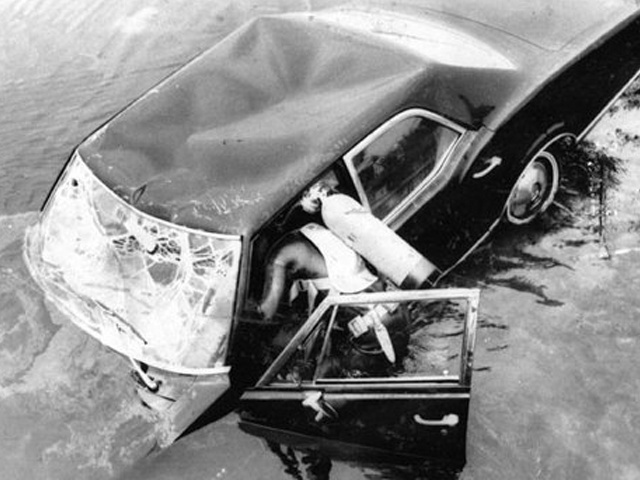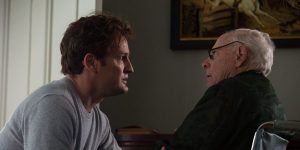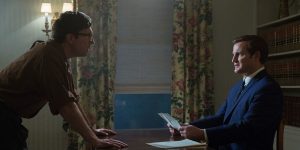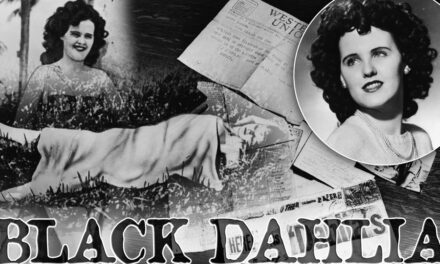The Ghosts of Chappaquiddick
The whole thing was a bit unseemly, from the start. A group of political men, most with pregnant wives, hosting an intimate, out-of-the-way gathering on Chappaquiddick Island in Massachusetts, attended by younger, single women. Even if the women were loyal employees, owed a little treat once in a while, it still looked bad. But the party, like a thousand others, would just be a tiny, dusty memory in history’s attic were it not for an unfortunate accident, one that tarnished the reputation of the son of America’s most dynamic political family.
Lovely and wholesome, Mary Jo Kopechne never returned from that island alive. In the official version she accepted a ride to the ferry by Senator Edward Kennedy, but he forgot a turn on a bridge, ditched in the water, and overturned. He escaped the car, but she didn’t. And it was hours before he reported the car and drowned girl to authorities, while the Kennedy family brain trust was summoned to the scene for damage control.
Voters back home in Massachusetts forgave Kennedy, although his national career suffered. Time moved on and he served an astounding 46 years in the U.S. Senate, until his death in 2009. But the cloud, the mystery, and the unseemly smell of the incident never entirely went away. The best spin doctors money can buy could never quite cleanse the image of a girl drowning in a car while the Senator went on about his business. And different theories have emerged of precisely what happened those hours of July 18 and early the 19th, 1969.
We set off to explore personal tragedy, wrapped in political intrigue.
MAKING SENSE OF A TIMELINE
According to Kennedy’s inquest testimony, he made a wrong turn onto Dike Road, which was an unlit dirt road that led to Dike Bridge (also spelled Dyke Bridge). Dike Road was unpaved, but Kennedy, driving at “approximately twenty miles an hour [30 km/h]”, took “no particular notice” of that fact, and did not realize that he was no longer headed toward the ferry landing. Dike Bridge was a wooden structure that at the time was not protected by a guardrail and was angled obliquely to the road. A fraction of a second before he reached the bridge, Kennedy applied his brakes and then drove over the side of the bridge. The car plunged into tide-swept Poucha Pond (there a channel) and came to rest, upside down, underwater. Kennedy recalled later that he was able to swim free of the vehicle, but Kopechne was not. At the inquest, Kennedy claimed that he called Kopechne’s name several times from the shore and tried to swim down to reach her seven or eight times. Knowing that the woman was still trapped inside the vehicle, Kennedy rested on the bank for around 15 minutes before he returned on foot to Lawrence Cottage, which was the site of the party that was attended by Kopechne and the other “boiler room girls”. Kennedy denied seeing any house with a light on during his walk back to Lawrence Cottage.
According to one commentator, Kennedy’s foot route back to Lawrence Cottage would have taken him past four houses from which he could have telephoned and summoned help before he reached the working phone at the cottage; however, he did not attempt to contact the local residents. The first of the houses, referred to as “Dike House”, was 150 yards away from the bridge and was occupied by Sylvia Malm and her family at the time of the incident. Malm stated later that she had left a light on at the residence when she retired that evening.
According to Kennedy’s testimony, Gargan and party co-host Paul Markham then returned to the waterway with him to try to rescue Kopechne. Both of the other men also tried multiple times to dive into the water and rescue Kopechne. Kennedy testified that their efforts to rescue Kopechne failed, and Gargan and Markham drove with him to the ferry landing. Both men insisted multiple times that the crash had to be reported to the authorities. According to Markham’s testimony, Kennedy was sobbing and on the verge of becoming crazed. Kennedy went on to testify, “I had full intention of reporting it. And I mentioned to Gargan and Markham something like, ‘You take care of the other girls; I will take care of the accident!’—that is what I said and I dove into the water. “Kennedy had already told Gargan and Markham not to tell the other women anything about the incident “because I felt strongly that if these girls were notified that an accident had taken place and Mary Jo had, in fact, drowned, that it would only be a matter of seconds before all of those girls, who were long and dear friends of Mary Jo’s, would go to the scene of the accident and enter the water with, I felt, a good chance that some serious mishap might have occurred to any one of them.”
Gargan and Markam later testified that they assumed that Kennedy was going to inform the authorities once he got back to Edgartown, and they did not do the reporting themselves. According to Kennedy’s own testimony, he swam across the 500-foot (150 m) channel, back to Edgartown and returned to his hotel room, where he removed his clothes and collapsed on his bed. Hearing noises, he later put on dry clothes and asked someone what the time was: it was something like 2:30 a.m., the senator recalled. He testified that, as the night went on, “I almost tossed and turned and walked around that room…. I had not given up hope all night long that, by some miracle, Mary Jo would have escaped from the car.”
Back at his hotel, Kennedy complained at 2:55 a.m. to the hotel owner that he had been awakened by a noisy party. By 7:30 a.m., he was talking “casually” to the winner of the previous day’s sailing race and gave no indication that anything was amiss. At 8:00 a.m., Gargan and Markham joined Kennedy at his hotel where they had a “heated conversation.” According to Kennedy’s testimony, the two men asked why he had not reported the crash. Kennedy responded by telling them “about my own thoughts and feelings as I swam across that channel… that somehow when they arrived in the morning that they were going to say that Mary Jo was still alive. “The three men subsequently crossed back to Chappaquiddick Island on the ferry, where Kennedy made a series of telephone calls from a pay telephone near the crossing. He made the phone calls to his friends for advice. Again, Kennedy did not report the crash to authorities.
Wikipedia
The basic timeline, itself, speaks volumes about the night of July 18, 1969, on the remote Island of Chappaquiddick off of Massachusetts. Mary Jo supposedly asked the Senator for a lift back to the ferry to return to her hotel room for the night, but left her keys and pocketbook behind. The Kennedy car was headed away from the ferry when it flipped over into the water.
This mystery is a death investigation and an historical conundrum, but it’s most intriguing questions may lie in the psyches of the Senator, his aides, the Massachusetts public.
When someone lies dead or dying in an overturned car, isn’t a no-brainer what needs to happen? After any rescue at the scene is attempted, official help is summoned. The authorities are notified. Does anyone over the age of eighteen, anywhere at any level of sophistication, have any trouble understanding that?
The Senator himself, in the televised speech designed to excuse his behavior overall, even conceded that his tardiness to talk to authorities was “indefensible.”
Senator Kennedy never reported the crime of his own volition, even the following morning. Only after the overturned car was discovered and identified as Ted Kennedy’s did he interact with law enforcement, and only then in guarded fashion.
To say that the Senator didn’t wish to be forthcoming about the accident is an understatement. What could have gone on in his mind for the ten hours before authorities were in touch with him? With a young woman dead or dying, below the water? What mental process could have possibly led him to delay alerting the authorities?
Concussion, shock, guilt, confusion? Or, some would speculate, the emotion of ‘political anguish.’ Is it true, or apocryphal that when first asked by intimates what happened? he replied “I’m not going to be president of the United States.”
Therefore Sherlock will forever contemplate two sets of questions about the Chappaquiddick incident. The first set of questions involve exactly what happened, and when to leave a vehicle upside down with Mary Jo inside of it.
The second set will involve human psyches, and hard-nosed Washington politics.
CHAPPA DOCUMENTARY
On July 18, 1969, Senator Ted Kennedy (Jason Clarke) is partying with friends on Chappaquiddick Island off the coast of Massachusetts. He’s the youngest Senate Majority Whip in history and a likely contender for the Presidency in 1972. Late that night, while driving with Mary Jo Kopechne (Kate Mara)—a friend (and possibly more) who worked with his brother Robert—his car heads off a bridge and into a pond. Somehow, Kennedy escapes the car, but Kopechne is trapped and drowns. In the fallout, Kennedy vacillates between doing the right thing no matter the consequences and trying to cover up any wrongdoing in order to protect his career.
One of the things I really loved about Chappaquiddick is how it wrestles with legacy. Ted Kennedy is a unique figure not just because of his last name, but also because of his relationship to his brothers. Forced into a career he may not have chosen due to his overbearing father Joe (Bruce Dern), Kennedy became the last best hope for the Kennedys after the deaths of John, Robert, and Joe Kennedy Jr. There was no one else to carry a baton of greatness, so in addition to dealing with the grief of losing all his brothers, he also had to be the leader they were supposed to be. That’s an unimaginable weight and the film constantly shows Ted grappling with this burden.
Thankfully, it never lets him off the hook. Curran and screenwriters Taylor Allen and Andrew Logan understand that while Kennedy faced arguably impossible expectations, he wasn’t exactly a victim. He was gifted with every kind of opportunity since birth, and when he was in a bind, his father was ready with an army of fixers to mitigate the damage. The average person in Kennedy’s situation who behaved the way he did—fleeing the scene, orchestrating a cover up, etc.—likely would have seen jail time. Kennedy used it as a starting point to reelection.
Watching Kennedy swing between opportunity and integrity can make for an odd tone. In one scene, Kennedy is stepping up and giving a statement to the police chief, and a few scenes later, he’s trying on a neck brace he doesn’t need because he believes it makes him look more sympathetic. In the hands of a less gifted actor, the character might seem contrived or inconsistent, but Clarke, one of the most underappreciated actors working today, makes everything click together. Although it would have been nice if the script let us get more of a baseline on Kennedy before the crash, we can at least understand how a person in his circumstances might constantly jump between doing what is right and doing what is easy.
When you consider the film’s about real-life politicians we usually get, Chappaquiddick is surprisingly bold even if its modest approach belies its striking statements. Kennedy died only eight years ago, the family is still fairly influential, and his grandnephew, Joe Kennedy III, is a rising star in the Democratic Party. And yet here is a movie basically arguing that Ted Kennedy left a young woman to drown and his foremost concern was how that would affect his chances of being President. He then went on to be memorialized and beloved. Chappaquiddick knows that when it comes to Ted Kennedy’s story, and especially this event, the best we can hope for is some kind of understanding. Garnering sympathy is best left to the politicians.
Matt Goldberg, collider.com, Sept. 14, 2017
As we approach the fifty-year anniversary, next year, of the Chappaquiddick debacle, interest has waned perhaps, but never really disappeared. The excerpt above refers to a review of a movie, based on the tragic incident, released some months ago. We’ve not been able to access the film, but we’re glad it’s out there, offering a generation not even alive at the time an introduction to a perplexing event, and one that likely changed history.
The Kennedy mystique of the 60’s survived in 1969 in the form of the handsome young Senator. He might well have spent eight years in the White House, absent his behavior on the night in question. That enticing historical context always added a layer of fascination to one of the more astonishing events involving a major pubic figure.
The reviewer comments on the portrayal of Kennedy as swinging “between opportunity and integrity.” The coldest possible look at the Senator’s actions, however, only give fuel to the ten or twelve dimensions of personal and political calculation. Discussing possible versions of the accident immediately with advisors on hand. Later, discussing damage control with every wise man that had ever helped the Kennedy dynasty. All the while failing to report a fatal accident to proper authorities.
Does an analysis of the event, and the mentalities operating that day, offer much evidence that “integrity” was a living element in the aftermath? …those who probe the human psyche may come to different conclusions …
It’s good that this dramatization, and the historical record, try to explore the nuances of character, and political heritage. Nothing’s worse than portrayals of events which are entirely one-sided.
And the portrayal, in it’s political setting, teases the question: Why were voters at the national level through with Kennedy after Chappaquiddick, and yet Massachusetts voters willing, in overwhelming numbers, to return him to his Senate seat eternally? He served 46 years.
ANOTHER TAKE…
Mara, too, is memorable in her limited screen time — which is the point. This isn’t Mary Jo’s story, but we get a sense of her grief over Bobby, her dedication to politics, and the kind of spiritual connection, and perhaps attraction, she felt with Teddy. “She always gets erased from the narrative; that can’t be helped,” Curran told me. “But we wanted to be honest about who she was. All those girls were highly educated, independent, ambitious, and integral to Bobby’s election campaign. History has sort of relegated her to being a footnote, just a secretary and they were sleeping together. There’s no evidence that they had a relationship.”
Even if they did, that’s not what matters. It’s one thing to know that a woman died that night in Teddy’s car, or to read a couple lines about it in a high-school textbook. It’s another to watch it happen, to see Mara as Mary Jo onscreen shouting for Teddy’s help, and gasping for breath in a small air pocket. What the film does best is lay out, in an increasingly horrible deluge, just how many baffling and criminally negligent actions — other than try to save Mary Jo’s life — Teddy took in the accident’s wake.
Among them:
- Pulling himself from the car, but not Mary Jo. He claimed he dove into the water seven or eight times to try to get her, but couldn’t get the doors open, and then collapsed on the bank of the water for some 15 minutes from exhaustion and shock.
- Not immediately running for help.
- Not stopping to phone the police at any of the four houses that were closer to the water than the cottage where the party was taking place.
- Still not phoning the police when he reached the cottage, but instead gathering up his cousin Joe Gargan (Ed Helms) and Gargan’s buddy, U.S. Attorney Paul Markham (Jim Gaffigan) to go back to the crash site to try to rescue Mary Jo. (In the movie, when they ask him what’s wrong, he replies, “I’m not going to be president.”)
- Not telling any of the other Boiler Room Girls about the accident because, he said in testimony, he was worried about their safety and the possibility that they would hurt themselves trying to dive down to rescue Mary Jo. (Not in the movie.)
- Still not reporting the accident, despite Gargan and Markham, both lawyers, insisting he had to.
- Swimming the channel, he testified, to get back to his hotel on a nearby island since the ferry was out for the night. (The movie suggests this was bullshit, and Gargan and Markham had taken Teddy by rowboat.)
- Complaining about a noisy party at his hotel.
- Dressing in a suit to call his father from a pay phone — and still not calling the police. (This may be the movie’s conjecture.
- Getting breakfast at the club with friends the next morning.
- Taking a ferry back to Chappaquiddick to make calls from a pay phone to friends asking for PR advice. Still not calling the police.
Instead — these are facts — someone else found the car and made the call the next morning. A diver retrieved Mary Jo’s body in 10 minutes (in the film, and in testimony, he says he could’ve gotten her out in 25 if he’d gotten the call). The way her neck was angled suggested that she’d been gasping for breath in an air pocket, and died of suffocation rather than drowning. And here’s the doozy: She may have been alive in that car for three or four hours after the crash. This is the part where you’ll want to throw your popcorn at the screen.
9/15/2017 vulture.com , Jada Juan
An excerpt from an excellent writer, triggered by the same docu-drama, that penetrates much of the same ground we’ve been exploring. And, by the way, regarding two confidants and attorneys who kept “insisting” that Kennedy call in the accident, did not have the skills to use a telephone. Perhaps Kennedy was too shaken to make good decisions, but they could have reported the accident using a phone in front of Kennedy, or called authorities and told him immediately afterward. As officers of the court, were they not guilty of betraying a sacred trust, and perhaps guilty in Mary Jo’s death as well, assuming she lingered a while in a air pocket?
The law never slapped them on the wrist. The psychology of Princes, and their minions?
It seems obvious the Senator lied: his destination with his passenger was surely not the ferry crossing. But even the “lawyers” testimony may have been false. At the distance of all these years, the specter of Kennedy swimming that distance is his mental and physical state raises doubts. How much of Kennedy’s broadcast version of events was a creative recollection of the facts?
MCGUINNIS ON CHAPPAQUIDDICK
It was Smith, with his unerring instinct for spotting rot at the core, who was first to recognize the true scope of the calamity. He hired at least seven lawyers to advise and represent Teddy, including Edward Hanify, a partner in the prestigious Boston firm Ropes & Gray. Outside of Washington, and certainly in Boston, no lawyer had stronger and deeper ties to the highest levels of the business and political establishments in Massachusetts than did Ed Hanify.
To have Hanify and Burke Marshall working together on a motor-vehicle case was considered the equivalent of bringing in the Queen Elizabeth and the Queen Mary to tow Teddy’s car up out of the pond. But Steve Smith was taking no chances.
Smith knew, before any of them—except perhaps Teddy himself—that the political thing was over now. There would be no presidential run in 1972. It might take the well-massaged public a decade or more to recognize it, but Steve Smith knew by the last week of July 1969 that Teddy’s future was already behind him.
To one who later wondered why the prolonged silence that so badly tarnished Teddy’s image had been permitted to continue, Smith bluntly explained the simple fact of life that governed the behavior of all those behind the compound fences during that time: “Our prime concern,” he said, “was whether the guy survived the thing. Whether or not he rode out the still-possible charge of manslaughter.”
By Sunday, having had the opportunity to scrutinize Teddy’s brief statement, the press was bombarding Jim Arena with many legitimate questions, to which he did not know the answers.
Most of the reporters had already been to Chappaquiddick. They’d driven the road. And they’d all come to the same, unavoidable conclusion: Teddy could not unknowingly have turned onto Dike Road.
First, the paved road, which curved sharply left at that point, had a white line down the middle, and a light-reflecting arrow on the side of the road clearly indicated the upcoming curve. In addition, the road was banked in the direction of the curve, so that, upon leaving it, a driver not only went suddenly from a surface of smooth pavement to a rough washboard of dirt and rock but also dropped about six inches in the process.
No one whose destination was the ferry could possibly have made that mistake. Teddy had known the name of Dike Road well enough to include it in the brief report he and Markham prepared. He also knew that bumpy, narrow Dike Road led not to the Edgartown ferry but to only one place: the bridge that crossed Poucha Pond and brought one to the deserted private beach he’d visited earlier that day. The implication was unmistakable: Teddy had been taking Mary Jo to the beach, not to the ferry.”
Joe McGinniss, Vanity Fair, September 1, 1993
From Vanity Fair’s feature, by the author of “Fatal Vision.” The full article’s a long read, but quite worthwhile if your at all serious about this story.
The appearance of infidelity, followed by involuntary manslaughter, followed by the cold and nakedest political calculation you’ve ever seen, is hard to escape. But the thing this article illuminates with a special glow–the utterly political fiber woven through everything that happened as that car and all those lives ended up upside down.
A whole study could launched to answer the question: when you assemble some of the best emergency fixers and PR people on the planet, do those poor optics outweigh anything the PR magicians themselves could conjure?
REMEMBRANCE
Dyke Bridge has crumbled in the last quarter of a century, as hurricanes and souvenir collectors have taken a toll. All that remains are 23 weathered wooden pilings jutting crookedly out of the water, connected here and there by a few jagged, graying beams. Still, the bridge has earned a distinction that is envied by many small innkeepers: a boldface entry in “Fodor’s Travel Guide.”
“It’s sort of regrettable to see how many people come just to see a bunch of pilings and wreckage and wood just because somebody famous drove off it in a foolish accident,” said Louis, who runs the stand with his 7-year-old sister, Margot, and charges 50 cents a cup.
NY Times, July 18, 1994
On the 25th anniversary of Chappaquiddick, what history has done to tourism, and the reverse.
Google the whole article for a “where are they now” perspective, the mini-stories speak for themselves.







